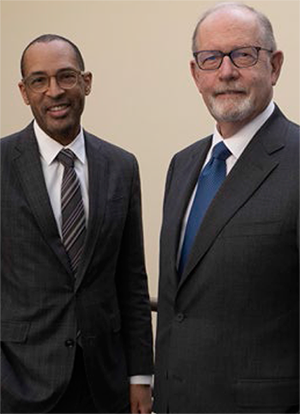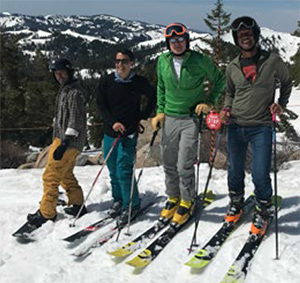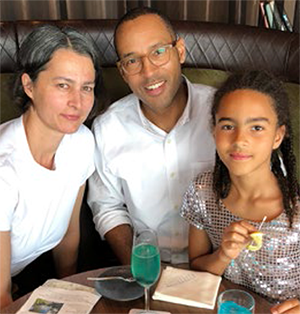Download PDF
On Feb. 1, Stephen D. McLeod, MD, stepped into the position of CEO of the Academy, where he will lead the field into the future. He takes the reins from David W. Parke II, MD, who led the Academy since 2009. Of his successor, Dr. Parke said, “Stephen brings to the Academy CEO position decades of experience in everything from clinical practice to science to advocacy to organizational management and leadership. Most importantly, he brings fresh new perspectives and priorities that every organization needs to continue to accelerate its value. And he is a proven winner at building and nurturing teams and coalitions. Don’t underestimate that critical skill set.”
To help members get to know the new CEO, EyeNet posed a few questions to Dr. McLeod.
How did you become interested in ophthalmology?
I went into medicine pluripotent as it were, but I realized throughout the course of my rotations as a medical student at Johns Hopkins that—uniquely—ophthalmologists were often able to definitively resolve the problems that brought patients to them. Many retinal detachments can be repaired with no substantial visual sequelae. Vision loss from ptosis can be completely cured. Cataract surgery is the most magical of all: Patients reported being better than they could remember. Of course, the hard, unresolved questions were less apparent to a medical student, but the stage was set by those early experiences in the clinic and the operating room: Ophthalmology was a field where you could help a lot of people in a profound way.
 |
|
NEW CEO. Dr. McLeod succeeds David W. Parke II, MD, as Academy CEO.
|
Briefly recap the trajectory of your career. What accomplishments are you most proud of?
When I finished my high school Cambridge A Level exams in Jamaica, as is typical in the educational system that the British West Indies adopted, I had planned immediate enrollment in medical school. However, I decided to take a year off for liberal arts study in the United States, after which I would decide about returning to the British system for medical education or continuing on to medical school in the United States. As it turned out, while I couldn’t match my father’s feat of a U.S. undergraduate degree in one intense calendar year, I was able to complete an undergraduate degree at Dartmouth comfortably within three years, after which I made the decision to remain in the U.S. system for medical school at Johns Hopkins University.
I found the Wilmer Eye Institute as a second-year medical student, and Sheila West and Harry Quigley as research mentors with whom I published my first first-author manuscript in Investigative Ophthalmology & Visual Science.
Mort Goldberg was the chair at Illinois Eye and Ear during that era, and still harboring visions of returning to Jamaica, I was particularly drawn to that program because of the work that Mort had done with Graham Sargent at the University of the West Indies in sickle cell retinopathy. Of course, after I matched there, Mort promptly decamped to Wilmer, but the Illinois Eye and Ear training experience was outstanding—and formative. My most influential mentor there was Joel Sugar, who is not only one of the finest ophthalmologists but also one of the finest physicians I have ever known.
Joel was my greatest influence in pursuing fellowship training in cornea and external disease, which I completed at Doheny Eye Institute with Ron Smith, John Irvine, and the youngest cornea faculty member, Peter J. McDonnell. I learned science from a lot of brilliant people, but from Peter I also learned how to write—he was efficient, organized, and prolific, and he was a generous mentor.
After fellowship, Joel gave me my first job as his practice partner back at the Illinois Eye and Ear Infirmary where I was introduced to contemporary refractive surgery. As it turns out, that was a growing niche across the country, and I made the decision to move to University of California, San Francisco (UCSF) largely based on the convergence of opportunity for practice and research in refractive surgery as well as the unique relationship of the department with the Francis I. Proctor Foundation. This offered opportunity in my other area of clinical and research interest, corneal disease and infectious keratitis.
UCSF turned out to be the ideal research and clinical environment with superb mentors and colleagues. The recruitment and then-mentorship cabal was the trio of Michael Drake (now president of the University of California), Creig Hoyt, who later took on the role of department chair, and Jack Whitcher, who was director of the Proctor Foundation. These three individuals stuck with me throughout my career at UCSF, and I’m deeply indebted to all of them. It was Creig who mentored me through the roles of medical director, to interim chair replacing him, and then to chair, and to this day when I have a problem, Creig is the one to solve it.
The accomplishments of which I am most proud are probably not surprising: They are what we have accomplished in ophthalmology at UCSF. It’s probably easiest to look to the tangible: at the end of my tenure, a successful $200 million campaign that has culminated in the building of a state-of-the-art eye center, the Wayne and Gladys Valley Center for Vision on a prime location with panoramic bay views on UCSF’s Mission Bay campus, the expansion of our research programs to achieve serial years of No. 1 ranking in NEI grant funding, a superb training program both clinical and scientific, and healthy operations with robust balance sheets. But what I’m most proud of is the faculty and the community we’ve built: an extraordinary group of brilliant and caring individuals who are aligned in a culture of excellence across all of our domains.
 |
|
OFF CAMPUS. Palisades at Lake Tahoe with UCSF ophthalmology faculty (from left, Dr. McLeod, Robert Bhisitkul, Bob Kersten, and Syd Williams).
|
How did you initially get involved with the Academy, and what factors kept you engaged?
It was really Richard Abbott who introduced me to the Academy. As with most people, I started as a committee volunteer. Rich was in charge of the Preferred Practice Patterns (PPP), and the Refractive Error PPP had not advanced beyond radial keratotomy. I was tasked with writing the sections on excimer laser refractive surgery. This was a classic case of one thing leading to another: I later was asked to chair revisions of that PPP, then to oversee the family of PPPs, and then to take on the secretary role under which the PPPs fall—the Secretary for Quality of Care.
Very well-defined factors kept me engaged. First, the time spent doing the work was well spent: I actually learned a great deal working on these committees because the writing process is scholarly and rigorous. If you know the material in an Academy education product, you know that topic area well. Moreover, the Academy is extremely good about engaging volunteers to the appropriate level of expertise: You never feel as if you are doing busy work, but rather work that actually requires your professional knowledge. Processes are well organized, and support staff are highly competent. The next big factor, actually, is the social aspect: I have met so many interesting peers in these work groups and committees whom I simply wouldn’t have met otherwise, and, of course, they were self-selected to be engaged and passionate and generous. And you had the opportunity to meet the senior luminaries in the field because of their activities in the Academy. Worthy cause, quality work, efficient use of time, great people: What’s not to love?
 |
|
EYE CENTER. The brand-new Wayne and Gladys Valley Center for Vision at UCSF.
|
What were your motivations for throwing your hat into the ring for the CEO position?
I have to admit—I was asked. It’s a brave person who unprompted sees themselves as the natural successor to someone like David Parke, and I’m not one of them. However, colleagues whom I trust and who care deeply about the Academy made a compelling case that while none of us is David, the role is vital for the profession and one of its highest callings.
What experiences from your past will be most valuable in your role as CEO?
The Academy is a large and complex organization that has to balance activities and priorities across multiple missions so as to meet the needs of a broad constituency. It requires a knowledge of the organization that comes from decades of service on committees and work groups through to the Board of Trustees. What has helped to prepare me for this? Running a large clinical department with departmental, multi-institutional, and health care system clinical services; clinical training programs from medical students through to residents and fellows; laboratory and clinical research programs; researcher trainees from graduate students to postdocs; and funding sources tied tightly to only two of those areas—clinical care and, if grant funded, research—is incomparable training in complex systems management and balancing the exuberance of vision with fiscal prudence. The CEO also interfaces with other medical societies and various federal agencies, and my extensive experience with federal agencies including the NIH and the FDA is invaluable.
Are you coming in with any specific goals that you’d like to accomplish?
Yes, the items that top my list are as follows:
- Position the organization strategically to anticipate and adapt to change, which is the hallmark of the health care environment around us.
- Truly understand the value propositions for members so that the organization meets the needs, both recognized and unrecognized, of its constituents.
- Ensure the sustainability of practice in our sphere of responsibility—vision care—within the broader health care system.
- Lead as a profession in translating science and outcomes data into practical guidance for everyday care decisions.
- Above all, we are here for our patients. This means we have to relentlessly drive alignment of the evolving health care system with the needs of our patients, with unwavering commitment to both quality and equity.
Will you continue to see patients?
If, as physicians, we actively see patients—and do surgery—an individual patient’s needs must be our first personal responsibility. In this transition, the needs of the Academy have to supersede all other professional obligations, so with no small regret, I’ve made the decision to step away from direct patient care.
What would you say has been the secret to your success?
Mentorship, sponsorship, discipline, a healthy dose of good fortune, and a really patient family including my wife, Marion.
 |
|
FAMILY. Appetizers with his wife, Marion Faymonville, and daughter, Elise McLeod, during a trip to Japan.
|
How have you balanced home and work demands? How do you relax outside of work?
Time management and discipline to minimize the amount of work taken home, an early start to the day and a late end notwithstanding. We enjoy an urban life but—as much as possible—get out to the Northern California wine country to relax. We have a hobby vineyard out there where I’m a struggling winegrower. I’ve played tennis all my life and am still avid, and in the winter months, there’s nothing I enjoy more than tackling double-black ski runs with my fearless daughter.